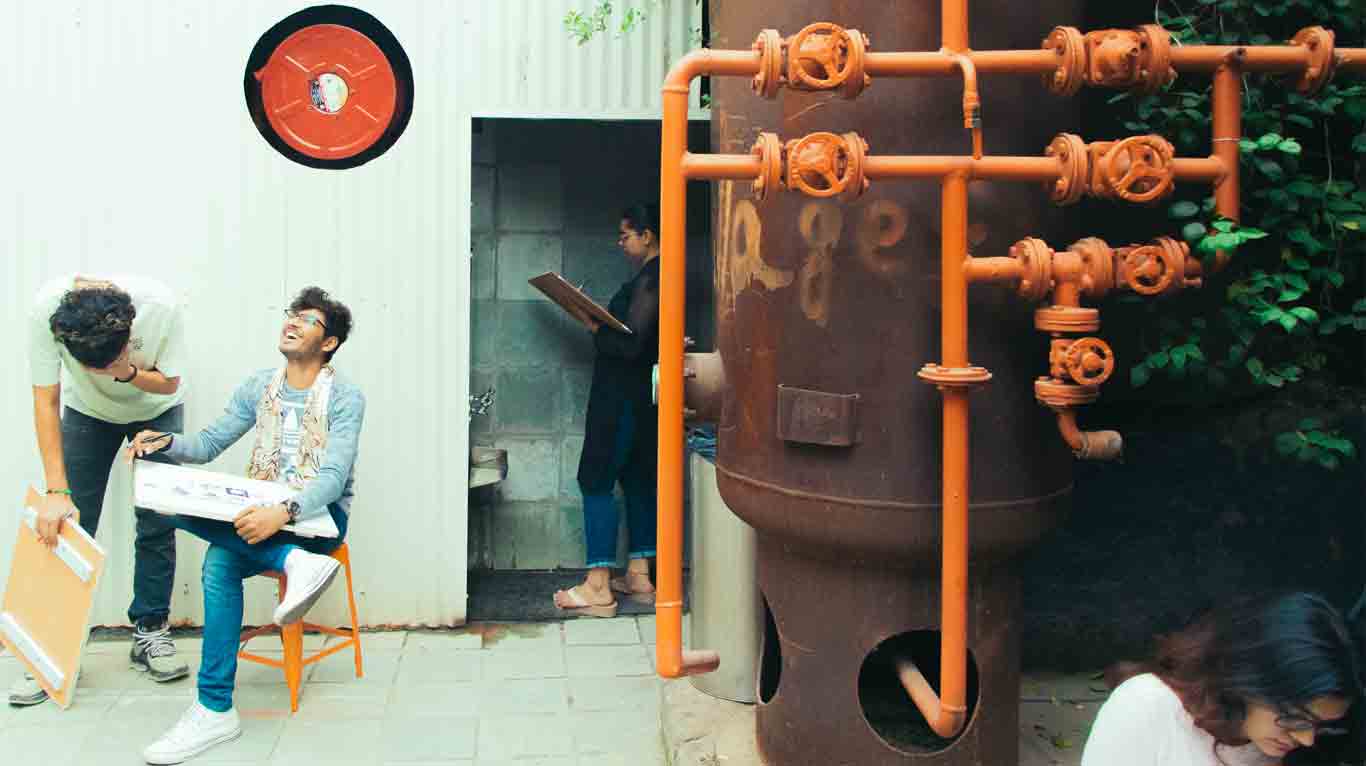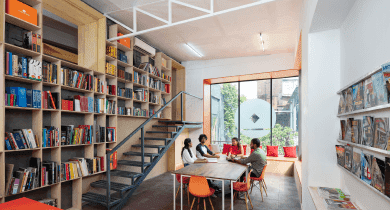Begin your creative journey and contribute to the future of design

The Design Village is a global ecosystem where learners want to learn and facilitators want to share their lived experiences. TDV thrives on curious and ambitious people who align with the village and are passionate about what they do.
TDV through its entrance exam wants motivated individuals with the potential to be future designers, people whose curiosity makes them aware of their surroundings and the ones who can take responsibility for their actions.
The examination process consists of a written exam/design test followed by a personal interview. Please scroll through to understand the components of the written exam.
The section tests the candidates with realistic yet hypothetical scenarios that they build around the prompts. It assesses the observation of a student toward the objects around us that we often overlook and how they function in a space, whether through displacement, projectile, remodelling or changing the point of impact.
How well a person can visualise an object through their drawings while keeping in mind the form, texture, proportions etc in 3-dimensional space is primary here. The physics of an object such as pull, fall, twist, break, splash, etc., and the level of investigation or curiosity with which one has comprehended the question are interesting components of this section.
The context in which one has placed the object while still keeping it in focus also matters immensely.
The potential to communicate an idea with the freedom of using any media available to a candidate is primary in this section. It could be paints, microns, markers, scrap materials such as old clothes, magazines, newspapers, posters, old labels and packaging along with basic stationery etc.
The test focuses on surfacing the inventive / experimental / imaginative and artistic capabilities of the candidate by putting them into a time-bound situation and indulging their minds to compose something meaningful.
Composition, imagination, courage, perseverance to explore the question, articulation in words and the ability to manipulate the materials and media to represent the mind are all being evaluated here.
Potential for compassion while at the same time, courage to build an argument and support it with logic and rationale is of essence in this section.
How one combines new information with the existing awareness that one has, about the world, to build a narrative is being evaluated here.
A candidate will display their ability to make correlations out of the information provided and the ability to use the medium creatively. The perseverance to delve deeper into research to get suitable information will be beneficial here.
The information and the prompt could be based on everyday lives or even the currently common global issues. It would depend on a candidate’s ability, awareness and curiosity to comprehend the prompt enough in order to build the story that they want to.
A brief discussion with the interviewer about personal goals, aspirations, opinions and ideologies so that the entrant’s alignment with design and TDV could be understood.
The section tests the candidates with realistic yet hypothetical scenarios that they build around the prompts. It assesses the observation of a student toward the objects around us that we often overlook and how they function in a space, whether through displacement, projectile, remodelling or changing the point of impact.
How well a person can visualise an object through their drawings while keeping in mind the form, texture, proportions etc in 3-dimensional space is primary here. The physics of an object such as pull, fall, twist, break, splash, etc., and the level of investigation or curiosity with which one has comprehended the question are interesting components of this section.
The context in which one has placed the object while still keeping it in focus also matters immensely.
The potential to communicate an idea with the freedom of using any media available to a candidate is primary in this section. It could be paints, microns, markers, scrap materials such as old clothes, magazines, newspapers, posters, old labels and packaging along with basic stationery etc.
The test focuses on surfacing the inventive / experimental / imaginative and artistic capabilities of the candidate by putting them into a time-bound situation and indulging their minds to compose something meaningful.
Composition, imagination, courage, perseverance to explore the question, articulation in words and the ability to manipulate the materials and media to represent the mind are all being evaluated here.
Potential for compassion while at the same time, courage to build an argument and support it with logic and rationale is of essence in this section.
How one combines new information with the existing awareness that one has, about the world, to build a narrative is being evaluated here.
A candidate will display their ability to make correlations out of the information provided and the ability to use the medium creatively to communicate the narrative. The perseverance to delve deeper into research to get suitable information will be beneficial here.
The information and the prompt could be based on everyday lives or even the currently common global issues. It would depend on a candidate’s ability, awareness and curiosity to comprehend the prompt enough in order to build the story that they want to.
A brief discussion with the interviewer about personal goals, aspirations, opinions and ideologies so that the entrant’s alignment with design and TDV could be understood.
Total no of seats : 120 seats
Minimum 50% score in Higher Secondary Examination or Class XII equivalent. The students must get through the TDV Design Entrance Test.
Candidates are chosen based on the written entrance exam and a personal interview conducted by TDV.
In special cases, TDV could consider student transfers from other institutes based on an interview, portfolio review, recommendation letters and UGC-approved previous marksheets. University rules and compliance shall be applicable for degree purposes.
Total no of seats : 30 seats
Minimum 50℅ score in under graduation. The students have to get through the TDV Design Entrance Test.
Candidates are chosen based on the written entrance exam and a personal interview conducted by TDV. A design portfolio* is not mandatory but a PG student is encouraged to share their design portfolio at the time of the interview.
Transfers in postgraduate courses are not applicable.
| COURSE FEE- UNDERGRADUATE | |
|---|---|
| One time Registration Fee | |
| Registration Fee (Non Refundable) | 30000 |
| Refundable Security | 20000 |
| TOTAL (ONE TIME) | 50000 |
| YEARLY FEES | ||||
|---|---|---|---|---|
| Year | Semester | Collaboration Fee | Tution Fee | Resource Fee |
| Year 1 | 1 | 120000 | 130000 | 110000 |
| 2 | 130000 | 110000 | ||
| Year 2 | 1 | 120000 | 130000 | 110000 |
| 2 | 130000 | 110000 | ||
| Year 3 | 1 | 120000 | 130000 | 110000 |
| 2 | 130000 | 110000 | ||
| Year 4 | 1 | 120000 | 130000 | 110000 |
| 2 | 130000 | 110000 | ||
| 480000 | 1040000 | 880000 | ||
| GRAND TOTAL | 2400000 | |||
SCHOLARSHIP
| Category | up to 100% | |
| TDV Entrance Exam | As per merit | For 1st year only |
| Siblings | 25% concession on Tuition Fees | Till the time both the siblings are in TDV |
| Defence | 25% concession on Tuition Fees | For 1st year only |
| Single Parent | 25% concession on Tuition Fees | For all years |
| Founder's Scholarship ( Need Based ) Case to Case | ||
Notes
| COURSE FEE - POSTGRADUATE | |
|---|---|
| One time Registration Fee | |
| Registration Fee (Non Refundable) | 30000 |
| Refundable Security | 20000 |
| TOTAL (ONE TIME) | 50000 |
| YEARLY ACADEMIC FEES | ||||
|---|---|---|---|---|
| Year | Semester | Collaboration Fee | Tution Fee | Resource Fee |
| Year 1 | 1 | 120000 | 130000 | 110000 |
| 2 | 130000 | 110000 | ||
| Year 2 | 1 | 120000 | 155000 | 110000 |
| 2 | 155000 | 110000 | ||
| 240000 | 570000 | 440000 | ||
| GRAND TOTAL | 1250000 | |||
SCHOLARSHIP
| Category | up to 100% | |
| TDV Entrance Exam | As per merit | For 1st year only |
| Siblings | 25% concession on Tuition Fees | Till the time both the siblings are in TDV |
| Defence | 25% concession on Tuition Fees | For 1st year only |
| Single Parent | 25% concession on Tuition Fees | For all years |
| Founder's Scholarship ( Need Based ) Case to Case | ||
Notes
REFUND POLICY
| Refund Timelines | Non-Refundable Component | Refundable Component |
| Any written withdrawal requests received up until 15 days before the class commencement date. | Registration Fee | Refundable Security & Course Fee |
| Any written withdrawal requests received during 15 days before the class commencement date. | Registration Fee & 50% Course Fee | Refundable Security & 50% Course Fee |
| Any written withdrawal requests received after the class commencement date. | Registration Fee & Course Fee | Refundable Security |
| Any written withdrawal requests received in the event of getting admission under Open / General category on merit (not sponsored, management or NRI quota) at NID (Ahmedabad or Gandhinagar), NIFT (Delhi, Hyderabad, Mumbai, Kolkata or Bangalore) and IITs, subject to submission of the proof of admission and its acceptance. | INR 10,000/- as Admission Processing Charge | * INR 40,000/- & Course Fee (100%) |
Notes
Begin your creative journey and contribute to the future of design

This mock test is a sample for the written entrance exam/design test. The actual test will be completely online and will test the potential of a candidate to be a design villager.

